Forays into Fantasy: William Hope Hodgson’s The Night Land
Scott Lazerus is a Professor of Economics at Western State Colorado University in Gunnison, Colorado, and has been a science fiction fan since the 1970s. The Forays into Fantasy series is an exploration of the various threads of fantastic literature that have led to the wide variety of fantasy found today, from the perspective of an SF fan newly exploring the fantasy landscape. FiF will examine some of the most interesting landmark books of the past, along with a few of today’s most acclaimed fantasies, in an attempt to understand the connections between fantasy’s origins, its touchstones, and its many strands of influence.
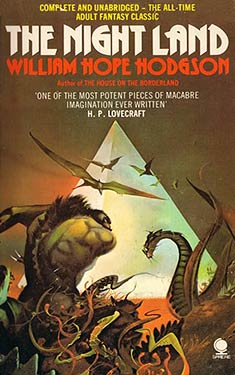 In an earlier Foray into Fantasy, I looked at William Hope Hodgson’s The House on the Borderland (1908) as an influential early precursor of the weird tale, a difficult-to-define subgenre of fantasy portraying incursions of the inexplicable or uncanny into our consensual reality. Since then, I’ve been looking forward to reading The Night Land (1912), Hodgson’s fourth and final novel, which, though sometimes cited as his masterpiece, is not as often read today due to its length and distracting pseudo-archaic English. While it certainly has touches of the weird, The Night Land is also an amalgamation of fantasy, science fiction, horror, and romance, its uniqueness compounded by its extremely unusual narrative viewpoint.
In an earlier Foray into Fantasy, I looked at William Hope Hodgson’s The House on the Borderland (1908) as an influential early precursor of the weird tale, a difficult-to-define subgenre of fantasy portraying incursions of the inexplicable or uncanny into our consensual reality. Since then, I’ve been looking forward to reading The Night Land (1912), Hodgson’s fourth and final novel, which, though sometimes cited as his masterpiece, is not as often read today due to its length and distracting pseudo-archaic English. While it certainly has touches of the weird, The Night Land is also an amalgamation of fantasy, science fiction, horror, and romance, its uniqueness compounded by its extremely unusual narrative viewpoint.
The first chapter tells of the courtship and marriage of Mirdath and the unnamed narrator. Based on the writing style and details of the setting, it seems to take place in England in the seventeenth century, though this is not specified. When Mirdath dies in childbirth, the narrator, who idealized his wife with an intense degree of sentimentality, is plunged into despair. Somehow, whether through some form of clairvoyant reincarnation or psychic time travel (the ambiguous possibility of both mystical and science fictional interpretations is characteristic of the novel), he finds himself occupying the mind of a young man living on the dying earth millions of years in the future, after the sun has stopped emitting visible light, and humanity has retreated into the “Great Redoubt”—a giant metal pyramid powered by the “Earth Current” and protected from the malevolent forces of the Night Land by a sort of force field. The remainder of the novel is narrated from the perspective of this seventeenth century Englishman, now with the knowledge of the young man of the future whose mind he co-occupies, describing this future dying earth and his quest to regain his lost love—a journey through a blighted landscape teeming with evil creatures.
The evil must surely have begun in the Days of the Darkening (which I might liken to a story which was believed doubtfully, much as we of this day believe the story of the Creation). A dim record there was of olden sciences … which, disturbing the unmeasurable Outward Powers, had allowed to pass the Barrier of Life some of those Monsters and Ab-human creatures…. And thus there had materialized, and in other cases developed, grotesque and horrible Creatures, which now beset the humans of this world. And where there was no power to take on material form, there had been allowed to certain dreadful Forces to have power to affect the life of the human spirit. And this growing very dreadful, and the world full of lawlessness and degeneracy, there had banded together the sound millions, and built the Last Redoubt; there in the twilight of the world… And when the humans had built the Great Pyramid, it had one thousand three hundred and twenty floors…. And the whole height of the pyramid exceeded seven miles, by near a mile, and above it was a tower from which the Watchmen looked (these being called the Monstruwacans)…. And when the Pyramid was built, the last millions, who were the Builders thereof, went within, and made themselves a great house and city of this Last Redoubt. And thus began the Second History of this world.
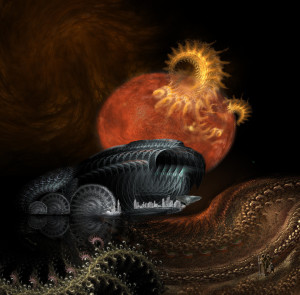 The people of the Last Redoubt have a degree of psychic ability, of which the narrator’s is the most developed. He finds himself in mental contact with Naani, a woman living in the Lesser Redoubt, another human settlement, the existence of which had previously been rumored but uncertain to those in the Last Redoubt. By way of this contact, the narrator learns that the Earth Current is no longer accessible to the Lesser Redoubt, which has fallen to the “Monsters and Ab-human creatures” of the Night Land, its inhabitants scattering and facing almost certain death without the protection of the Redoubt. He also becomes convinced that Naani is destined to be his “Maid”—his eternal perfect love, Mirdath reincarnated. The novel, then, tells of our hero’s solo journey through the Night Land and its environs to find the Lesser Redoubt, rescue Naani, and bring her back to the safety of the giant pyramid, armed only with his “Diskos”—a rotating-disc-gun powered by the Earth Current and attuned to his mind—and provisioned with a supply of food pills, which provide all necessary nutrition but leave him feeling constant hunger, and vials of chemical dust that turn to water when exposed to air.
The people of the Last Redoubt have a degree of psychic ability, of which the narrator’s is the most developed. He finds himself in mental contact with Naani, a woman living in the Lesser Redoubt, another human settlement, the existence of which had previously been rumored but uncertain to those in the Last Redoubt. By way of this contact, the narrator learns that the Earth Current is no longer accessible to the Lesser Redoubt, which has fallen to the “Monsters and Ab-human creatures” of the Night Land, its inhabitants scattering and facing almost certain death without the protection of the Redoubt. He also becomes convinced that Naani is destined to be his “Maid”—his eternal perfect love, Mirdath reincarnated. The novel, then, tells of our hero’s solo journey through the Night Land and its environs to find the Lesser Redoubt, rescue Naani, and bring her back to the safety of the giant pyramid, armed only with his “Diskos”—a rotating-disc-gun powered by the Earth Current and attuned to his mind—and provisioned with a supply of food pills, which provide all necessary nutrition but leave him feeling constant hunger, and vials of chemical dust that turn to water when exposed to air.
Hodgson’s evocation of this strange future world is the amazing aspect of The Night Land. Readers and critics have complained about the distracting pseudo-archaic language of the novel, but one possible reason Hodgson may have used it was to further enhance the weirdness of the setting. The strange and horrifying creatures that lurk in every crevice of the blighted landscape in this dark future, many seemingly descended from crabs, spiders, rats, and other less familiar forms, seem even odder when described by a narrator transported from three or four centuries in our past:
[T]here came very quick, a great and ugly thing, that had an ugly way of putting down the feet, and did have seven feet to each side, which was very strange; and the back was as that it were horny, and the belly of the thing did seem to brush heavy upon the earth, and it grunted, as it went, and shook the earth with the weight of it; so that a monstrous noise came from it, upon so hasty a journey…. And it did go under the tree in which I was hid; and in that moment when it past under the tree, the seven Humped Men did leap out of the branches, and did catch to the brute by the great horns of the spine…
This is just one example of the dozens of monsters hatched in Hodgson’s imagination. The vile-smelling slugs as big as houses, to mention one more example, are not to be missed. As H. P. Lovecraft wrote in his 1927 essay “Supernatural Horror in Literature”, “in [the narrator’s] slow, minutely described, day-by-day progress over unthinkable leagues of immemorial blackness there is a sense of cosmic alienage, breathless mystery, and terrified expectancy unrivalled in the whole range of literature.” He calls The Night Land “one of the most potent pieces of macabre imagination ever written.” On the other hand, Lovecraft doesn’t mince words in regard to what he sees as the novel’s failings, pointing out that The Night Land “is seriously marred by painful verboseness, repetitiousness, artificial and nauseously sticky romantic sentimentality, and an attempt at archaic language even more grotesque and absurd than that in [Hodgson’s 1907 novel The Boats of the] ‘Glen Carrig’.”
The repetitiousness arises from Hodgson’s decision to allow his narrator to describe his journey in minute detail—a decision that contributes to our immersion in this strange world, but which often becomes irritatingly redundant. How often must we have described to us the ritual of consuming the food pills and water? Worst of all is the narrator’s tic of inserting unneeded clauses such as “in verity,” “and this shall be plain unto you,” or “and this thing you shall agree with me to be a reasonable thinking,” every second paragraph or so. At one point, we are addressed as follows: “And surely all this to be plain to you, and to be over-plain; for, in verity, I tell to you, and over-tell, until that I should be weary; and mayhap you to be the more so. [Amen!] And, indeed, I not to blame you; but only hope that your understanding, which doth mean also in general your hearts, doth be with me along my way.”
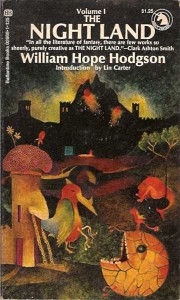
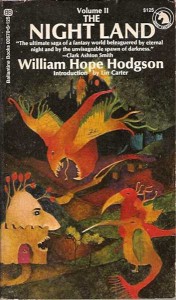 And then there is that “nauseously sticky romantic sentimentality.” Clearly, the romantic theme is just as important as the fantastic elements to Hodgson, who subtitled the first British edition of the The Night Land, “a Love Tale.” As he writes in the first chapter: “truly Love and Pain do shape the Character of Man.” It’s possible that another reason behind the choice to use an archaic-sounding narration was to reinforce the idea that love has the power to extend through the ages, unchanging from centuries past into the present, and forward into the far-distant future, as long as humanity endures. Unfortunately, in order to help forward this theme, Hodgson spends much of the last third of the novel—once our hero has completed his journey to the Lesser Redoubt, rescued Naani, and begun the return trek with her—describing their budding adolescent romance in excruciating detail.
And then there is that “nauseously sticky romantic sentimentality.” Clearly, the romantic theme is just as important as the fantastic elements to Hodgson, who subtitled the first British edition of the The Night Land, “a Love Tale.” As he writes in the first chapter: “truly Love and Pain do shape the Character of Man.” It’s possible that another reason behind the choice to use an archaic-sounding narration was to reinforce the idea that love has the power to extend through the ages, unchanging from centuries past into the present, and forward into the far-distant future, as long as humanity endures. Unfortunately, in order to help forward this theme, Hodgson spends much of the last third of the novel—once our hero has completed his journey to the Lesser Redoubt, rescued Naani, and begun the return trek with her—describing their budding adolescent romance in excruciating detail.
The first discovery of love, and the development of the dynamics of a young relationship, while understandably fascinating to the characters intimately involved, held almost no interest for me as a reader, and seemed especially distracting as they played out on a journey back to the Great Redoubt during which they were in serious danger at every moment. The problem is compounded by the fact that the relationship, supposedly representing the eternal ideal of love between man and woman, takes the form of establishing the dynamic of “Master” and “Maid”—terms used repeatedly by the narrator throughout the novel. Naani, who “thrill[s] in her womanhood unto the man that did be so masterful to her,” during one section goads her “Master” into repeatedly slapping her, as this seems to be the only way he can force an end to her “dainty foolishness,” after a lover’s tiff causes her to run off into the Night Land by herself, putting them both in serious danger. Reestablishing his dominance, which Naani accepts gratefully, our hero reflects: “And in verity a young man doth want that he whip his maid and kiss her, and all in the one moment. And, indeed, he to have delight in both. And she obeyed me that time, as always when I did be earnest, without more word. And surely that Naughty One did know how I loved her.” This sort of thing continues off and on for over a hundred pages, punctuated by action sequences as the Master selflessly protects his Maid. (To Hodgson’s credit, he does include one incident where the Maid must rescue the Master!)
As a reader, I rarely skim, generally believing that, if a book is worth reading, it is important to experience the language and craft of the writer, as intended. But I did find myself skimming through the two long chapters detailing the return journey, skipping over these annoying passages while waiting for more monsters to appear and distract the couple from their interminable mundane courtship, and the narrator from his sexist musings.
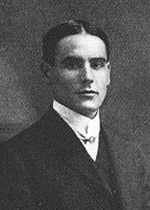 The Night Land, then, is a “problem novel.” I hesitate to call it a flawed masterpiece, as the flaws are so significant, and are bound to put off so many readers. As a result, it doesn’t entirely stand the test of time. Its faults are especially unfortunate, since its virtues are undeniable, and it is an important milestone in fantastic fiction. Hodgson was a major influence on the contributors to Weird Tales. His novel anticipates the development of the “dying earth” story—an idea that would be taken up by Clark Ashton Smith and, of course, Jack Vance, who did not write his better-known take on the idea until over three decades after Hodgson’s novel. Leaving aside the mystical aspects, it can be seen as an interesting forerunner of far future science fiction. The science is now outdated, but the world Hodgson depicts—a nearly dead sun thirty million years hence, orbited by an earth whose rotation has greatly slowed, and where the warmth needed for life exists only in deep fissures subject to volcanic emissions—is consistent with the theories of Lord Kelvin, considered the authority on physics in Hodgson’s time, and was probably influenced by H. G. Wells’s description of the far future in The Time Machine (1895). And, most importantly, the cumulative effect of its length and specificity of description represents a world-building achievement of a strangeness and intensity rarely matched. The Night Land is a book to contend with.
The Night Land, then, is a “problem novel.” I hesitate to call it a flawed masterpiece, as the flaws are so significant, and are bound to put off so many readers. As a result, it doesn’t entirely stand the test of time. Its faults are especially unfortunate, since its virtues are undeniable, and it is an important milestone in fantastic fiction. Hodgson was a major influence on the contributors to Weird Tales. His novel anticipates the development of the “dying earth” story—an idea that would be taken up by Clark Ashton Smith and, of course, Jack Vance, who did not write his better-known take on the idea until over three decades after Hodgson’s novel. Leaving aside the mystical aspects, it can be seen as an interesting forerunner of far future science fiction. The science is now outdated, but the world Hodgson depicts—a nearly dead sun thirty million years hence, orbited by an earth whose rotation has greatly slowed, and where the warmth needed for life exists only in deep fissures subject to volcanic emissions—is consistent with the theories of Lord Kelvin, considered the authority on physics in Hodgson’s time, and was probably influenced by H. G. Wells’s description of the far future in The Time Machine (1895). And, most importantly, the cumulative effect of its length and specificity of description represents a world-building achievement of a strangeness and intensity rarely matched. The Night Land is a book to contend with.
William Hope Hodgson seemed to truly believe in the sentimental heroic ideal portrayed through the main character of his novel. As a teenager, he ran away from home to sea. Bullied and abused by his fellow sailors, he determined never to be in such a position again, devising a physical training regimen that he later attempted to market through his “School of Physical Culture” in 1899. Discharged due to a serious head injury during World War I, he soon insisted on re-enlisting, and was killed by artillery in 1918, at age 40. It’s difficult to resist contemplating what an artist lost to us in his prime might have accomplished, but even though his career was cut short, Hodgson remains an important name in the history of fantasy. Night Shade’s five-volume Collected Fiction of William Hope Hodgson, now out of print but still available digitally, is the best place to rediscover this unique imagination, and his works are freely available in the public domain.



















 Full Details
Full Details


3 Comments
Thanks for the interesting review,Scott,as informative and thoughtful as ever.But I see what you meant about tackling The House on the Borderlands first.In fact I very much doubt if I will ever attempt this book ever!How interestimg that he was the origin of The Dying Earth genre,but Vance obviously leaned lessons on how to better present it
Great review of NIGHT LAND which is a very important novel and yet also significantly flawed. Were it not for the extreme imagination shown in the first 2/3rds of the novel, I doubt if most would recall it at all. BTW, you may be interested in the WILLIAM HOPE HODGSON BLOG which I maintain at williamhopehodgson.wordpress.com where I talk about many aspects of this very interesting writer’s life and work!
@dusty: If you really like House on the Borderland, you might try chapter two of The Night Land. You’ll be able to tell pretty quickly if you think it’s worth continuing, and the description of the Great Redoubt is worth reading on its own.
@Sam: Thanks… I will check out the blog. Despite the flaws, I’ve found Hodgson to be a fascinating writer, and am interested in reading more of his work at some point.
Sorry, the comment form is closed at this time.